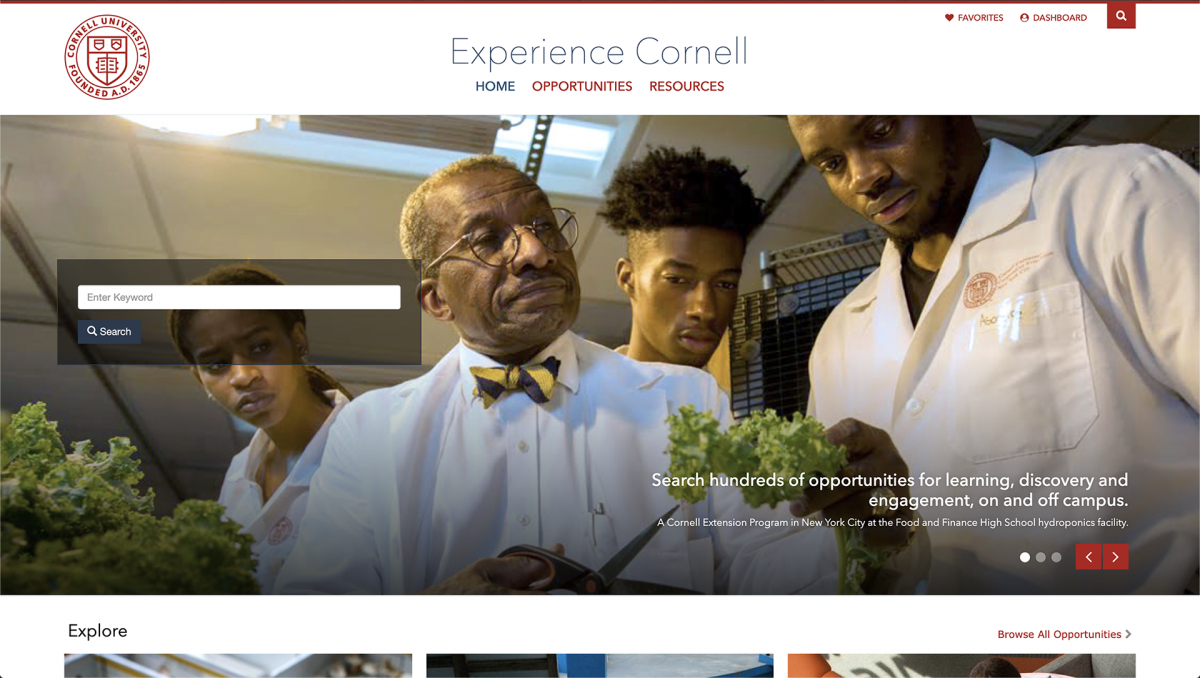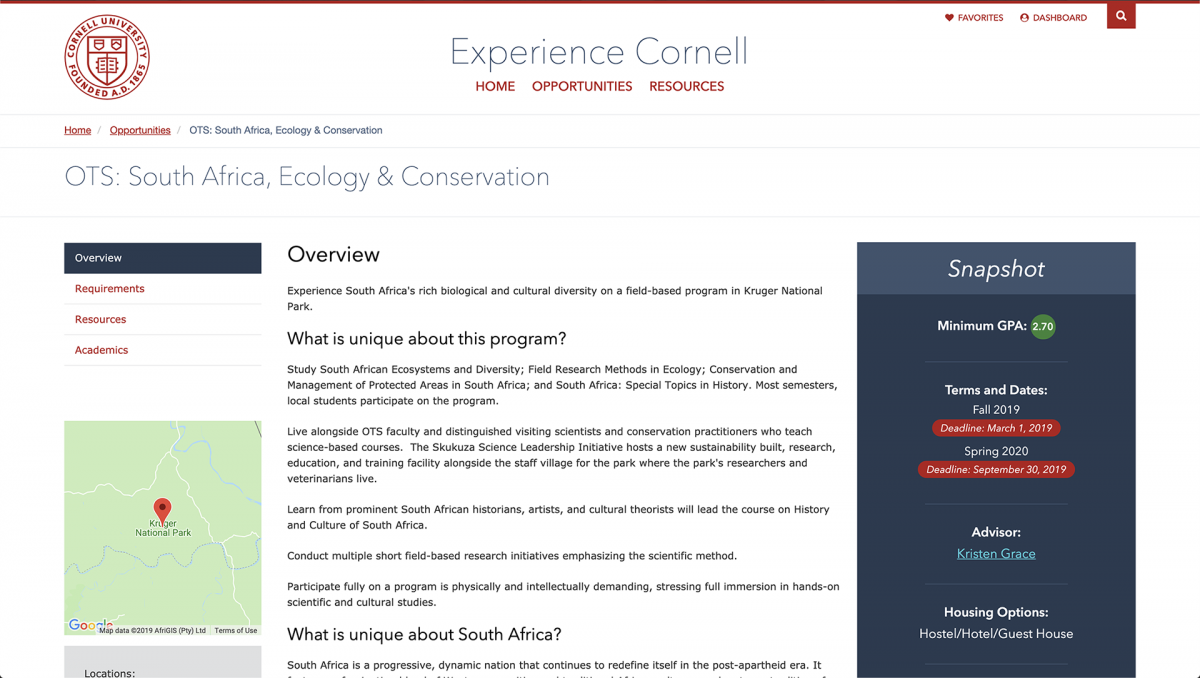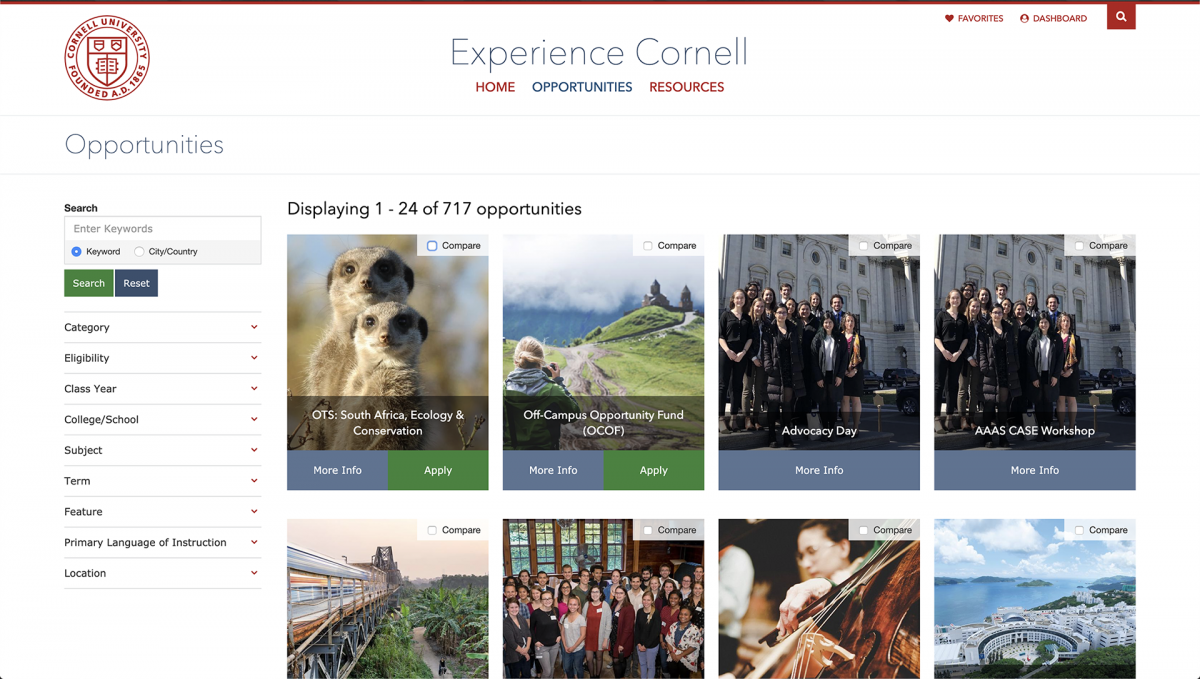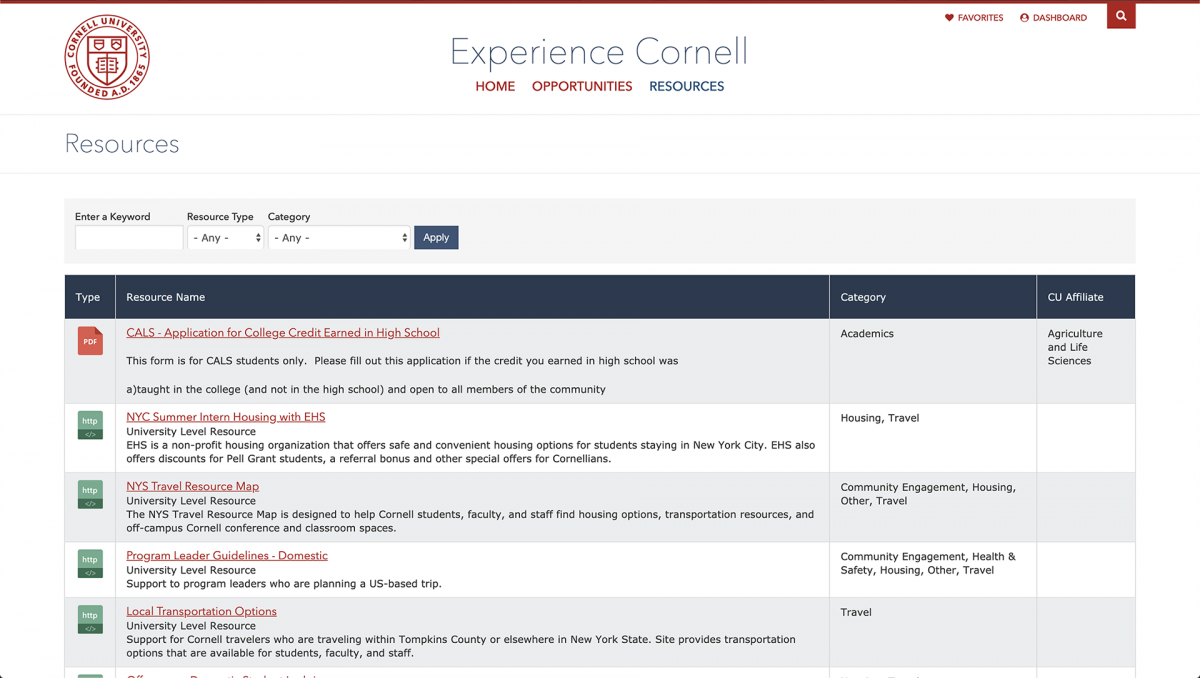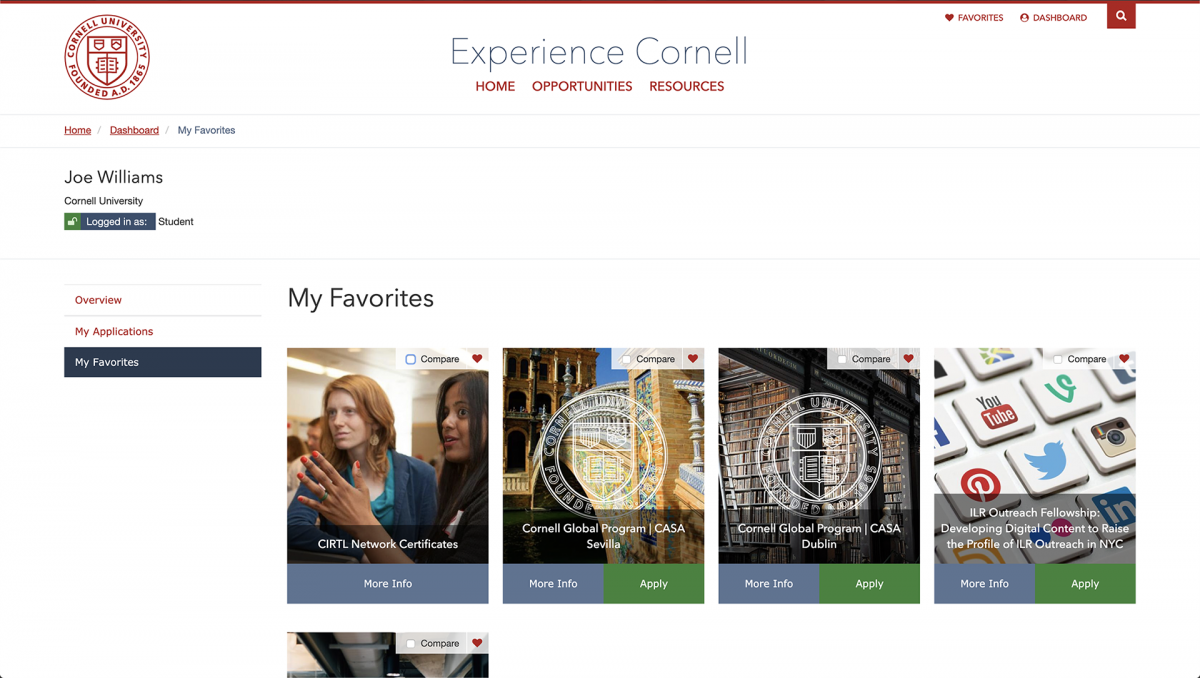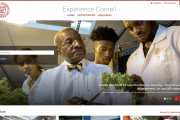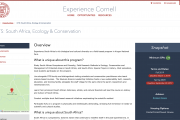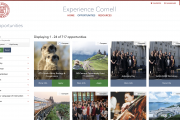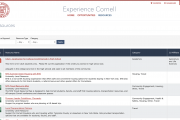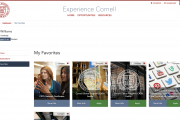Experience Cornell

Education
Case description
The newly relaunched Cornell Experience site features a branded front-end paired with powerful CRM tools behind the scenes, which makes the project innovative and unique. As students navigate all that Cornell has to offer, data helps advisers engage, provide support and resources, and understand the impact these programs have on students’ success.Experience.cornell.edu provides an elegant front-end experience designed to help students discover all of the student-centric offerings at Cornell. The site presents suggestions and allows users to compare programs and mark them as “favorite.” Students can refine their search by categories (such as subject area, college or school, term, and location), and then drill down further to see additional details (such as summaries, cost information, and deadlines). As part of the relaunch, we gathered real-world feedback from users, working in real-time with the platform. This allowed us to better adjust the site to meet the needs of the end-user and to provide a customized journey, that was not possible with the previous site. Additionally, the platform goes beyond a traditional website and raises the bar with the following three distinguishing features:
1. Extendability. By using Drupal (our CMS) to create a central “system of record” for all the programs offered at Cornell, we have created a more streamlined process and removed the need for thousands of websites having to hard code their own content. Instead, site owners can now push and pull live content directly from the Experience platform. The content can also be pushed out through digital signage across campus and tailored based on time and location.
2. Scalability. By using Salesforce (our CRM) to automate the engagement process, we can scale the service model for program administration across the entire university. The system includes an application builder, application processing tools, dashboards, automated emails, and a planned campaign management feature. We estimate more than 2,000 advisors and program administrators will be using this system within 3 years, replacing the current system they use which is often a blend of paper and Excel.
3. Analytics. A typical destination website does not include the type of data needed for robust analytics of a given population (for example, it only tracks who comes to the site, not who doesn’t). Our solution is architected on an enterprise CRM platform. For the first time, we are able to combine the bio/demo data of our entire population with engagement data, relationship data, and academic progress data. This will give university leaders, faculty, and administrators an unprecedented understanding of the impact of our programs and outreach on our students.
Case goals and results
The Experience initiative, which has sponsorship from the highest levels of the university and across every college, was focused on the following two goals:Goal 1: Develop student success metrics based on data.
The result: In order to address this goal, the Experience website, which is Drupal-based, was integrated with Salesforce. This pairing enabled us to leverage both platforms to create a seamless user-experience for front-end users and internal users alike. With the newly revamped Experience website, Cornell is now able to collect information that was not possible to obtain previously such as engagement data and information about co-curricular program participation. As a result of this new ability to collect data, the University created an Analytics Working Group led by the Vice Provost of Undergraduate Education, faculty researchers interested in learning analytics, and key administrators to analyze and interpret the data collected and to develop action items related to increasing students’ academic achievement, well-being, equity and inclusion, and goal fulfillment.
Goal 2: Replace siloed legacy websites with an all-inclusive solution to facilitate cross-departmental collaboration
The result: In the past few years, the University has begun to address issues around technical debt. Through the implementation of the Experience website, Cornell is able to maintain a centralized pool of data that is kept up-to-date and accurate, whereas previous websites, which were often singular user-task focused, often did not provide the same quality of data. While not a cost-saving to implement, the Experience site offers a cost-value to the University though it’s KPI’s measuring student access, participation, and impact.
Challenges
The challenge: CMS vs CRM?One of the main challenges that we had was that there is no one size fits all technology and you need to use technology for what it was intended. CMS and CRM are very robust technologies but, neither can really be used to replace the other. The CMS is great for building personalized, elegant websites and custom layouts with related/suggested content to end-users based on a students’ behavior at a given moment. CRM tools link up data about students from a variety of sources, including the website, email, meetings, and marketing efforts. They let a staff member manage interactions with students based on who they are and what they do – as they move through experience over time.
Cornell could have built a site that just searched for experiences and stopped there. Students would be able to discover opportunities but we would have no idea what they are actually doing. But without a CRM, there would be no student dashboards, no administrative support tools to help manage applicants, and no ability to report on participation trends and outcomes. Our “front end” needs a “back end.”
At the same time, if we had focused only on CRM/Salesforce, we would not have cultivated the rich web ecosystem needed for adoption. We could not provide a personalized content experience with ratings and favorites. We would not be able to push content out to other websites and across campus through digital signage. And we would not be able to have our content be discoverable on external search engines.
The solution: Why not both?
The key to creating a website that not only looks great but functions great on both the front and back-end is using the CMS and CRM systems together and harnessing the tools and power of each. By modifying how Drupal works, we were able to marry the two systems and maximize the benefits of both, including the creation of a common dashboard, all without sacrificing the unique features and offerings of each system.
Community contributions
With Salesforce becoming a solution that many are turning to for collecting customer data, we have created a solution that pairs the strengths of Drupal with the strengths of Salesforce to create a uniquely powerful, and user-friendly ecosystem. Working closely with the developer of the Salesforce module, we helped to resolve some bugs with that module and recommended feature improvements that could be used in future versions of the module.Why should this case win the splash awards?
• We have combined our Drupal content management system (CMS) with Salesforce customer relationship management (CRM) technologies to create a state-of-the-art system of engagement.• We are unifying data from multiple sources into a single holistic view of the student.
• We are powering university analytics with engagement data in order to understand how different touchpoints impact student success, where to invest, and what’s not working.
Time and time again, Cornell has built static web pages or invested in third-party solutions that are effective up to a point and then fall short because the sites aren’t fully aware of the customer or because they address a single business process but can’t connect to other parts of the student experience. For this initiative, Cornell leveraged the strengths of Drupal and Salesforce to seamlessly weave together a dynamic web experience layered on top of a powerful data foundation that is up-to-date and in-sync with active business processes.
Experience.cornell.edu is an enterprise system of engagement that is always aware of the underlying data and can take advantage of that data in unique and impactful ways. The combination of CMS and CRM creates a powerful system of engagement. This technology strategy is Cornell’s secret to business intelligence. A typical destination website does not include the type of data needed for robust analytics (for example, it only tracks who comes to the site, not who doesn’t). By architecting our solution on an integrated CRM platform, we are able to combine the bio/demo data of our entire population with engagement data, relationship data, and academic progress data. This gives university leaders an unprecedented understanding of the impact of our programs and outreach on our students. To date, we have anecdotal evidence that exposure to programs is driving an increase in applications. For example, a research center that sponsors internships in oceanography, food security, and other areas of ‘planetary health’ reported a 300% increase in applications from 50 to more than 200.
The true ROI of this initiative will be realized through the engagement data that we are collecting as students move through the many sub-journeys (research, study abroad, engaged learning, fellowships) of their overall Cornell experience. The platform tracks more than a dozen key sensor points such as when a student checks in for an advising appointment, when they apply to a program, whether they are denied or accepted, and when the program completes. On a micro level, this data will help advisors monitor student well-being and direct resources to students as they need them. On a macro level, by combining the engagement data with bio/demo data, university leaders will have a powerful new way to understand how different experiences, outreach, and interventions play a role in student success.
One additional benefit of a centralized “system of engagement” has been the ability to reduce university spend on custom development of applications. Within higher ed, there is no scalable, off-the-shelf product for integrated program management, application management, and advising. As a result, colleges and units have spent years building and maintaining their own custom solutions. A comparison of the cost to build a new website from scratch shows the university will save approximately $15,000 for each program that uses the central solution. Three programs will go live in March resulting in an immediate savings of $45,000. Others will follow. We also anticipate the retirement of legacy systems which will save substantially on maintenance costs.

